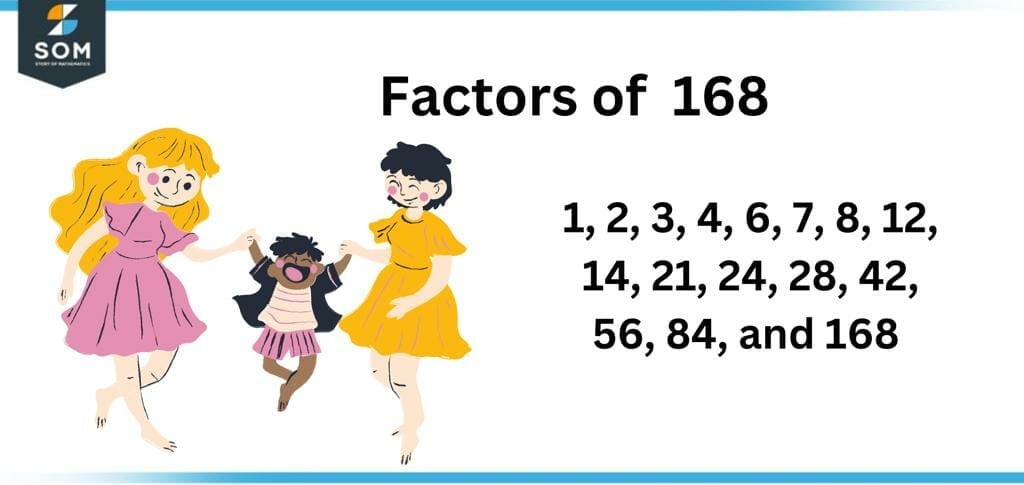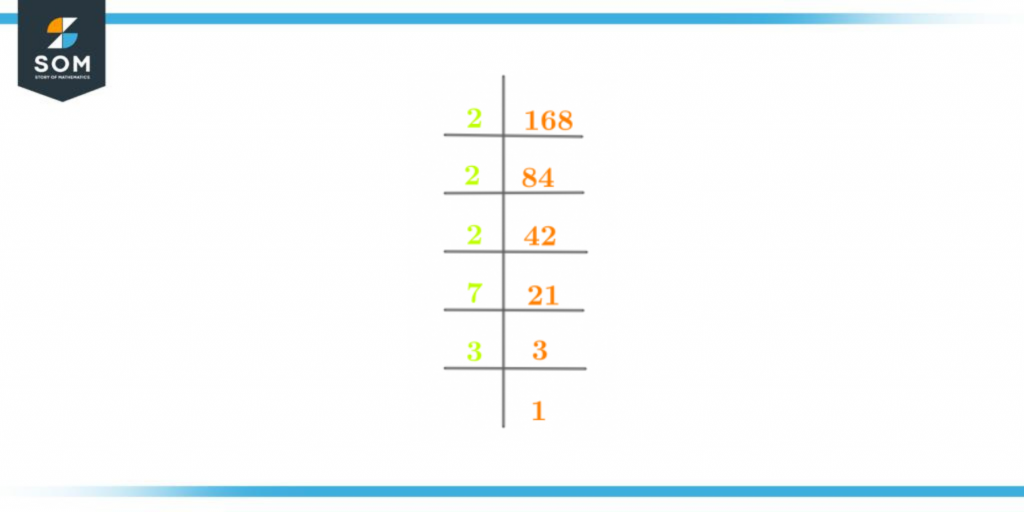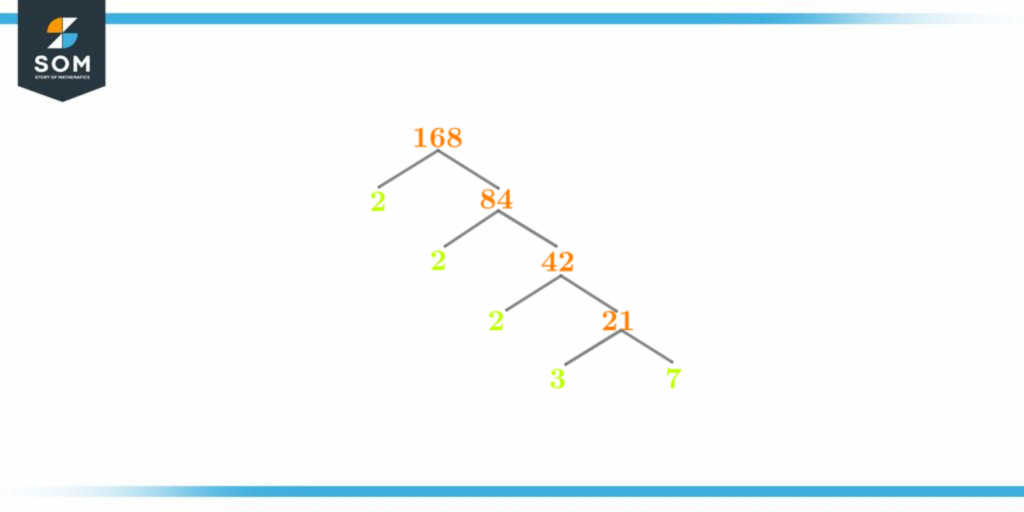JUMP TO TOPIC
Factors of 168: Prime Factorization, Methods, Tree, and Examples
The factors of 168 are categorized as those numbers which give 168 as the result when these numbers are multiplied by one another. Natural numbers that yield the original number as the product are known to form a factor pair.
Figure 1 – All possible Factors of 168
What Are the Factors of 168?
The factors of 168 are the following: 1, 2, 3, 4, 6, 7, 8, 12, 14, 21, 24, 28, 42, 56, 84, and 168. These are the numbers upon which 168 can be divided as a whole.The number 168 has a total of 16 factors. These 16 factors can be paired into 8-factor positive and negative.How To Calculate the Factors of 168?
You can calculate the factors of 168 through the most popular factor-calculating method, the division method. This method is very reliable and is entirely based on the division operation.Before moving on to the application of the division method on the number 168, we first need to address the fact that the number 168 is a big number. It will become quite a tedious process for determining the factors of 168 since infinite possibilities exist.Therefore, an easy way to determine the factors of 168 is first to determine the range. This range refers to the limit of numbers between which the factors of 168 lie. The range of factors for any number is between one and a half of that number.Since half of 168 is 84, this indicates that the factors of 168 will lie between 1 and 84. Now, let’s move on to the division method. The number 168 is an even number so let’s first consider its division with the number 2:\[ \frac{168}{2} = 84 ]\Since a whole number quotient is produced as a result of this division, hence this process proves that the number 2 is a factor of 84.Let’s take a look at all the other factors of 168:\[ \frac{168}{1} = 168 \]\[ \frac{168}{3} = 56 \]\[ \frac{168}{4} = 42 \]\[\frac{168}{6} = 28 \]\[ \frac{168}{7} = 24 \]\[ \frac{168}{8} = 21 \]\[ \frac{168}{12} = 14 \]\[ \frac{168}{14} =12 \]\[\frac{168}{21} = 8\]\[\frac{168}{24} = 7\]\[\frac{168}{28} = 6 \]\[ \frac{168}{42} = 4 \]\[ \frac{168}{56} = 3 \]\[ \frac{168}{84} = 2 \]\[\frac{168}{168} =1\]So the list of all the factors of 168 are:Factors of 168 are the following: 1, 2, 3, 4, 6, 7, 8, 12, 14, 21, 24, 28, 42, 56, 84, and 168Moreover, since there are two sides to a natural number, one positive and one negative, we will also observe some negative factors in this article.As mentioned above, two sides exist for every natural number, so the same is the case with the factors of 168. These factors can be negative as well. A negative sign accompanies the negative factors.The negative factors of 168 are given below:Negative Factors of 168 = -1, -2, -3, -4, -6, -7, -8, -12, -14, -21, -24, -28, -42, -56, -84, and -168In the world of mathematics, various procedures and techniques can be implemented practically to determine these factors. To find out the factors of 168, we will take a closer look at three techniques – the division method, the prime factorization method, and the factor tree.Factors of 168 by Prime Factorization
Prime factorization is one method used to determine only the prime factors of a number. The prime factors refer to those factors, which are factors as well as prime numbers, hence prime factors.The foundation of the prime factorization method rests on the division operation. In prime factorization, the number itself acts as the base number, and the division process is conducted via prime numbers. The whole number quotient produced in each step of the division takes the place of the dividend, and the entire princess is repeated until one is present at the end.The prime factorization of the number 168 is shown below:168 $\div$ 2 = 84
84 $\div$ 2 = 42
42 $\div$ 2 = 21
21 $\div$ 7 = 3
3 $\div$ 3 = 1
This prime factorization can be mathematically written as:Prime Factorization of 168 = 2 x 2 x 2 x 7 x 3
Prime Factorization of 168 = $2^{3}$ x 3 x 7
The prime factorization is also shown in figure 1 given below:
Figure 2 – Prime Factorization of 168
Factor Tree of 168
The factor tree is a tree-like structure used to evaluate a number’s prime factors. The factor tree is a network of branches that links multiple numbers together.The factor tree of the number 168 is given below in figure 2:
Figure 3 – Factor Tree of 168
Factors of 168 in Pairs
The factors of any number can also be arranged in the form of pairs. These pairs are known as factor pairs. A factor pair consists of two numbers subjected to multiplication, producing the original number as the product. As the number 168 has a total of 16 factors, these 16 factors can be grouped into 8-factor pairs.The positive factor pairs for the number 168 are given below:1 x 168 = 168
2 x 84 = 168
3 x 56 = 168
4 x 42 = 168
6 x 28 = 168
7 x 24 = 168
8 x 21 = 168
12 x 14 = 168
So the factor pairs are:Factor Pairs of 168 = (1, 168), (2, 84), (3, 56), (4, 42), (6, 28), (7, 24), (8, 21), and (12, 14)Negative factors exist for the number 168, so negative factor pairs exist. These negative factor pairs have a negative sign with both numbers, so the multiplication of these signs produces a positive sign.The negative factor pairs are given below:-1 x -168 = 168
-2 x -84 = 168
-3 x -56 = 168
-4 x -42 = 168
-6 x -28 = 168
-7 x -24 = 168
-8 x -21 = 168
-12 x -14 = 168
So the negative factor pairs are:Negative Factor Pairs of 168 = (-1, -168), (-2, -84), (-3, -56), (-4, -42), (-6, -28), (-7, -24), (-8, -21), and (-12, -14)Factors of 168 Solved Examples
To further enhance our understanding of the concepts of the factors of 168, let’s look at some solved examples involving these factors.Example 1
Calculate the average of all the factors of 168.Solution
For calculating the average of all the factors of 168, let’s first list down the factors of 168. These factors are given below:Factors of 168 = 1, 2, 3 ,4, 6, 7, 8, 12, 14, 21, 24, 28, 42, 56, 84, and 168Now, the formula for average is given below:\[ Average = \frac{\text{Sum of all factors of 168}}{\text{Total number of factors of 168}} \]According to this formula, we need two quantities – the sum of the factors of 168 and the total number of factors of 168. We know that the total number of factors of 168 is 16, so let’s calculate their sum.Calculating their sum below:Sum of factors of 168 = 1 + 2 + 3 + 4 + 6 + 7 + 8 + 12 + 14 + 21 + 24 + 28 + 42 + 56 + 84 + 168
Sum of factors of 168 = 480
Calculating the average:\[ Average = \frac{480}{16} \]Average = 30
So the average of all the factors of 168 is 30.